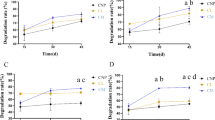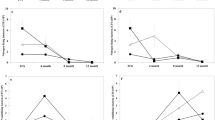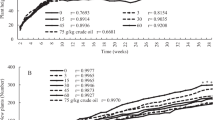Abstract
Goal, Scope and Background
The goal of this study was to understand the interaction between plants and microorganisms during petroleum-hydrocarbon bioremediation in Pacific Islands coastal soils. Total bacteria and hydrocarbon-degrading microorganisms population dynamics were examined in the rhizospheres of tropical trees and shrubs, which were evaluated for their phytoremediation potential in a greenhouse experiment. The respective and combined effects of plant roots and diesel contaminant on the microbial populations were determined in relation to diesel fuel depletion. An increase in the size of the hydrocarbon-degrading populations of microbes, elicited by rhizodeposition, is generally regarded as conducive to an enhanced degradation of petroleum hydrocarbon pollutants in vegetated soil.
Methods
The soil was a coastal sandy loam (pH 7.8) which was artificially contaminated with 10 g of No. 2 diesel fuel/kg soil or left uncontaminated. The pots were irrigated with fertilizer and 1% NaCl. The enumerations were carried out in the contaminated and uncontaminated rhizospheres of three trees, kiawe(Prosopis pallida), milo(Thespesia populnea), and kou(Cordia subcordata) and three shrubs, beach naupaka(Scaevola sericea), false sandalwood (Myoporum sandwicense), and oleander(Nerium oleander). Unplanted control soils were included in the experiment. Total bacteria and phenanthrene-degrading bacteria were enumerated on plates. Diesel- and pristane-de-grading microorganisms were enumerated by the most-probable-number technique in tissue-culture plates.
Results and Discussion
All four types of microorganisms responded to the rhizosphere of the 6 plants in uncontaminated soil and to the diesel contaminant in unplanted soil. In contaminated rhizospheres, no effect of the plant on the hydrocarbon-degrader numbers was visible. Total bacteria responded more to the plant roots than to the contaminant. The phenanthrene-degrading bacteria and pristane-degrading microorganisms were more influenced by the contaminant than by the plants. The diesel-degrading microorganisms were equally stimulated by the plants and the contaminant. The numbers of hydrocarbon degraders were similar in the contaminated rhizospheres of the three effective plants (kiawe, kou, and milo) and in those of the three ineffective shrubs.
Conclusion
The results suggest the quality of the rhizodeposition is plant-dependent and governs the type of diesel-degrader populations that will be enhanced by a given plant.
Recommendations and Outlook
In the proposed phytoremedia-tion-benefit model plant roots maintain high levels of hydrocarbon degraders in uncontaminated soil. When the root enters a contaminated zone of soil, those hydrocarbon degraders that prefer the contaminant would switch to the contaminant as a carbon source, effectively removing the hydrocarbons. If the root exudates and the contaminant are equally attractive to the hydrocarbon degraders, the contaminant degradation would be less effective.
Similar content being viewed by others
References
Alexander M (1979): Introduction to soil microbiology, 2d ed. New York: Wiley & Sons
Alexander M (1982): Most probable number method for microbial populations. In: Page AL (Ed). Methods of soil analysis, part 2, Madison, Wisconsin: American Society of Agronomy, Inc, pp 815–820
Alexander M (1999): Biodegradation and Bioremediation, 2d ed. New York: Academic Press
Anderson TA, Guthrie EA, Walton BT (1993): Bioremediation in the rhizo-sphere. Environ Sci Technol 27, 2630–2636
Aprill W, Sims RC (1990): Evaluation of the use of prairie grasses for stimulating polycyclic aromatic hydrocarbon treatment in soil. Chemosphere 20, 253–265
Banks MK, Govindaraju RS, Schwab AP, Kulakow P (2000): Part I: Field demonstration. In: Fiorenza S, Oubre CL, Ward CH (Eds). Phytoremediation of Hydrocarbon-Contaminated Soil, Lewis Publishers, Boca Raton, pp 3–88
Bogardt AH, Hemmingsen BB (1992): Enumeration of phenanthrene-de-grading bacteria by an overlayer technique and its use in evaluation of petroleum-contaminated sites. Appl Environ Microbiol 58, 2579–82
Bowen GD (1980): Misconceptions, concepts and approaches in rhizosphere biology. In: Ellwood D C, Latham M J, Hedger J N, Lynch J M, Slater JH (Eds). Contemporary microbial ecology, Academic Press, New York, pp 283–304
Brown EJ, Braddock J (1990): Sheen screen, a miniature most-probable-number method for enumeration of oil-degrading microorganisms. Appl Environ Microbiol 56, 3895–96
Bushnell LD, Haas HF (1941): The utilization of certain hydrocarbons by miçroorgansims. J Bacteriol 41, 653–673
Chaudry Q, Schroder P, Werck-Reichhart D, Grajek W, Marecik R (2002): Prospects and limitations of phytoremediation for the removal of persistent pesticides in the environment. ESPR-Environ Sci & Pollut Res 9, 4–17
Crowley DE, Alvey S, Gilbert ES (1997): Rhizosphere ecology of xenobiotic-degrading microorganisms. In: Kruger EL, Anderson, TA, Coats JR (Eds). Phytoremediation of soil and water contaminants. American Chemical Society Symposium Series 664, American Chemical Society, Washington, DC, pp 20–36
Cunningham SD, Anderson TA, Schwab AP, Hsu FC (1996): Phytoremediation of soils contaminated with organic pollutants. Adv. Agr. 56, 55–114
Curl EA, Truelove B (1986): The Rhizosphere. Berlin: Springer-Verlag
Donnelly PK, Hedge RS, Fletcher JS (1994). Growth of PCB-degrading bacteria on compounds from photosynthetic plants. Chemosphere 28, 981–988
Eweis JB, Ergas SJ, Chang DPY, Shroeder ED (1998): Bioremediation Principles. Boston: WCB-Mcgraw-Hill
Flathman PE, Lanza GR (1998): Phytoremediation: Current views on an emerging technology. J Soil Com 7, 415–432
Fletcher JS, Hedge RS (1995): Release of phenols by perennial plant roots and their potential importance in bioremediation. Chemosphere 31, 3009–3016
Foth HD, Turk LM (1972): Fundamentals of Soil Science, 5th ed. Wiley & Sons, New York
Greenberg AE, Trussel RR, Clesceri LS, Franson MAH (1985): Standard methods for the examination of water and wastewater. Washington DC, American Public Health Association
Günther T, Dornberger U, Fritsche W (1996): Effects of ryegrass on biodégradation of hydrocarbons in soil. Chemosphere. 33, 203–215
Haby PA, Crowley DE (1996): Biodegradation of 3-chlorobenzoate as affected by rhizodeposition and selected carbon substrates. J Environ Qual 25, 304–310
Harder W, Dijkhuizen L, Veldkamp H (1984): Environmental regulation of microbial metabolism. In: Kelly DP, Carr NG (Eds). The Microbe 1984, Part II Prokaryotes and Eukaryotes, Cambridge University Press, Cambridge, pp 51–95
Hutchinson SL, Banks, MK, Schwab AP (2001): Phytoremediation of aged petroleum sludge: Effect of inorganic fertilizer. J Environ Qual 30, 395–403
Johnsen AR, Winding A, Karlson U, Roslev P (2002): Linking of microorganisms to phenanthrene metabolism in soil by analysis of13C-labelled cell lipids. Appl Environ Microbiol 68: 6106–6113
Keck J, Sims RC, Coover M, Park K, Symons B (1989): Evidence of co-oxidation of polynuclear aromatic hydrocarbons in soil. Wat Res 23, 1467–1476
Lee E, Banks MK (1993): Bioremediation of petroleum-contaminated soil using vegetation: A microbial study. J Environ, Sci. Health A 28, 2187–2198
Liste H, Alexander M (1999a): Accumulation of phenanthrene and pyrene in rhizosphere soil. Chemosphere. 40, 11–14
Liste H, Alexander M (1999b): Rapid screening of plants promoting phenanthrene degradation. J Environ Qual 28, 1376–1377
Marschner P, Crowley DE (1996): Physiological activity of a bioluminescentPseudomonas fluorescens (strain 2-79) in the rhizosphere of mycorrhizal and non-mycorrhizal pepper(Capsicum annuum L.). Soil Biol Biochem 28, 869–876
Mills AL, Breuil C, Colwell R (1978): Enumeration of petroleum-degrading marine and estuarine microorganisms by the most probable number method. Can J Microbiol 24, 552–557
Miya RK, Firestone MK (2000): Phenanthrene-degrader community dynamics in rhizosphere soil from a common annual grass. J Environ Qual 29, 584–592
Miya R, Firestone MK (2001): Enhanced phenanthrene biodégradation in soil by slender oat root exudates and root debris. J Environ Qual 30, 1911–1918
Normander B, Hendriksen NB, Nybroe O (1999): Green fluorescent protein-markedPseudomonas fluorescens: Localization, viability, and activity in the natural barley rhizosphere. Appl Environ Microbiol 65, 4646–4651
Olson PE, Fletcher JS (1999): Field evaluation of mulberry root structure with regard to phytoremediation. Biorem J 3, 27–33
Paquin D, Ogoshi R, Campbell S, Li QX (2002): Bench-scale phytoremediation of polycyclic aromatic hydrocarbon-contaminated marine sediment with tropical plants. Int J Phytorem 4, 297–313
Pochon J, Tardieux P (1962): Techniques d’analyse en microbiologie du sol. St Mande, France: Editions de la Tourelle
Reilley KA, Banks MK, Schwab AP (1996): Organic chemicals in the environment: dissipation of polycyclic aromatic hydrocarbons in the rhizosphere. J Environ Qual 25, 212–219
Rovira AD (1965): Interactions between plant roots and soil microorganisms. Ann Rev Microbiol 19, 241–266
Schmidt SK, Scow KM, Alexander M (1987): Kinetics ofp-nitrophenol mineralization by aPseudomonas sp.: Effects of second substrates. Appl Environ Microbiol 53, 2617–2623
Schwab AP, Banks MK (1994): Biologically mediated dissipation of polyaro-matic hydrocarbons in the root zone. In: Anderson TA, Coats JR (ds). Bioremediation through Rhizosphere Technology, Amer. Chem. Soc. Symp. Ser. 563, pp 132–141
Siciliano SD, Germida JJ, Banks K, Greer CW (2003): Changes in microbial community composition and function during a polyaromatic hydrocarbon phytoremediation field trial. Appl Environ Microbiol 69, 483–489
Sims RC, Overcash MR (1983): Fate of polynuclear aromatic compounds (PNAs) in soil-plant systems. Res Rev 88, 1–68
Sun WH, Lo JB, Robert FM, Ray C, Tang CS (2004): Phytoremediation of petroleum hydrocarbons in tropical coastal soils: I. Selection of promising woody plants. ESPR-Environ Sci & Pollut Res 11 (4) 260–266
Tang CS, Sun WH, Toma M, Robert FM, Jones RK (2004): Evaluation of the agriculture-based phytoremediation in Pacific Island ecosystems using trisector-planters. Int J Phytorem 6, 1–17
Timonin MI (1940): The interaction of higher plants and soil microorganisms. I. Microbial populations of rhizosphere of seedlings of certain cultivated plants. Can J Res 18 (c) 307–317
Wiltse CC, Rooney WL, Chen Z, Schwab AP, Banks MK (1998): Greenhouse evaluation of agronomic and crude oil-phytoremediation potential among alfalfa genotypes. J Env Qual 27, 169–173
Author information
Authors and Affiliations
Corresponding author
Rights and permissions
About this article
Cite this article
Jones, R.K., Sun, W.H., Tang, CS. et al. Phytoremediation of petroleum hydrocarbons in tropical coastal soils II. microbial response to plant roots and contaminant. Environ Sci & Pollut Res 11, 340–346 (2004). https://doi.org/10.1007/BF02979649
Received:
Accepted:
Issue Date:
DOI: https://doi.org/10.1007/BF02979649




